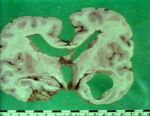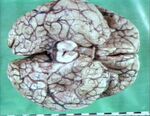Difference between revisions of "CNS Congenital Abnormalities - Pathology"
Jump to navigation
Jump to search
| Line 26: | Line 26: | ||
* A defect in the cranium allows protrustion of the brain and meninges. | * A defect in the cranium allows protrustion of the brain and meninges. | ||
| − | ** There is | + | ** There is always crania bifida (a split skull). |
* Meningoencephalocoele may be inherited in pigs and cats. | * Meningoencephalocoele may be inherited in pigs and cats. | ||
Revision as of 09:41, 28 August 2009
| This article has been peer reviewed but is awaiting expert review. If you would like to help with this, please see more information about expert reviewing. |
|
|
Introduction
- Congenital malformations may involve the spinal cord, brain, meninges, calvaria or vertebral column.
- Abnormalities typically result from defects in neural tube development.
- Congenital malformations are present at or before birth, and manifest as either:
- Morphological problems
- Functional problems
- Tend to arise as biochemical abnormalities, such as the lysosomal diseases or leukodystrophies.
- Causes of congenital abnormalities include:
- Environmental causes
- For example, these may be toxic, infectious, nutritional, or physical (e.g. radiation)
- This is by far the most common cause.
- Inherited traits.
- Environmental causes
Meningoencephalocoele
- A defect in the cranium allows protrustion of the brain and meninges.
- There is always crania bifida (a split skull).
- Meningoencephalocoele may be inherited in pigs and cats.
Hydrocephalus
- Hydrocephalus is an increased accumulation of fluid in the cranial cavity.
- There are several different types of hydrocephalus relating to where the fluid is located within the cavity.
- Internal hydrocephalus - fluid is within the ventricles
- The most common type.
- There is unilateral or bilateral dilation of the ventricles.
- External hydrocephalus - fluid is within the arachnoid space
- Communicating hydrocephalus - fluid is within the ventricles and arachnoid space
- Hydrocephalus ex vacuo - the ventricle is dilated secondary to loss of cerebral tissue
- Also known as compensatory hydrocephalus.
- Internal hydrocephalus - fluid is within the ventricles
View images courtesy of Cornell Veterinary Medicine
Causes
- Hydrocephalus may be congenital.
- Congenital hydrocephalus is common in brachycephalic and small breed dogs.
- It occurs sporadically in cattle.
- Obstructive lesions are often not found.
- Amalformed mesencephalic aqueduct may be involved.
- The cranium may be abnormal, for example, doming.
- Congenital hydrocephalus is common in brachycephalic and small breed dogs.
- Acquired hydrocephalus is the result of obstruction, usually due to inflammation or compression.
- Space-occupying lesions include :
- Neoplasms
- Abscesses
- Cholesteatomas
- Inflammation of meninges and/or ependymal cells can lead to hydrocephalus.
- For example, FIP causes ependymitis which can obstruct flow if it affects the mesencephalic aqueduct.
- Space-occupying lesions include :
- Hydrocephalus may also arise with:
- Increased ventricle size due to loss of brain parenchyma.
- Overproduction of CSF
- Rare
- Associated with choroid plexus tumours.
Breed predisposition
- Some breeds are predisposed to hydrocephalus.
- Chihuahua, pomeranian, yorkshire terrier, english bulldog, lhasa apso, toy poodle, cairn terrier, boston terrier, pug, pekingese, maltese terrier.
- Hydrocephalus has also been described in
- Bullmastiffs, in association with cerebellar ataxia.
- Siamese cats, as an autosomal recessive trait.
Clinical Signs
- Clinical signs are the result of:
- Loss of neurons or neuronal function
- Alterations in intercranial pressure
- Pathophysiological effects of intracranial disease
- Signs reflect the anatomical level of disease involvement.
- Rostrotentorial, vestibular and cerebellar signs are most common.
- Signs are not related to the degree of ventricular dilation. They are more associated with other damage caused by the disease proces:
- Intracranial pressure changes
- Intraventricular haemorrhage
- Speed of ventricular obstruction
- Hydrocephalus may contribute to abnormalities of skull development, where it is a congenital disease.
- Thinning of the bone structure
- Dome-shape head
- Persistent fontanelles
- Ventral or lateral strabismus may occur, although the reason for this is unknown.
- May be related to distortion of the orbits, due to skill deformity.
- May be realted with pressue on the mesencephalic tegementum.
Diagnosis
- Diagnosis is by a variety of imaging and electrophysiologic methods.
- MRI allows examination of the ventricular system, and give better resolution of the brain parenchyma than CT.
Treatment
- Prognosis is generally poor.
- Medical treatment:
- General supportive care
- Medications to limit CSF production and reduce intracranial pressure.
- Surgical treatment:
- Aims to allow drainage of CSF from the brain to another site for absorption.
Cerebellar Defects
- Cerebellar defects include:


